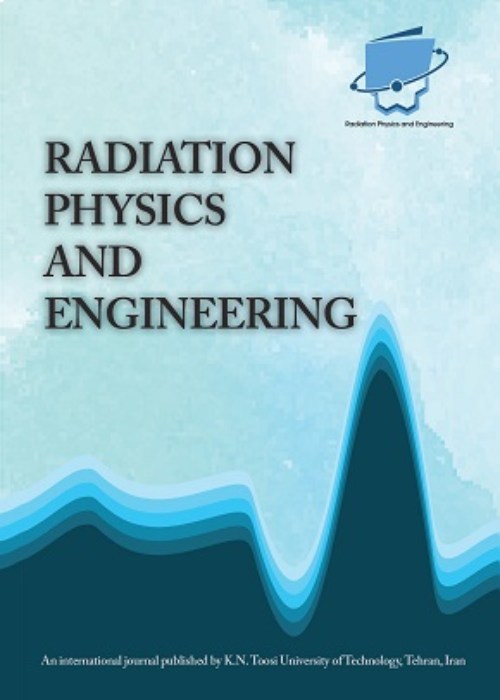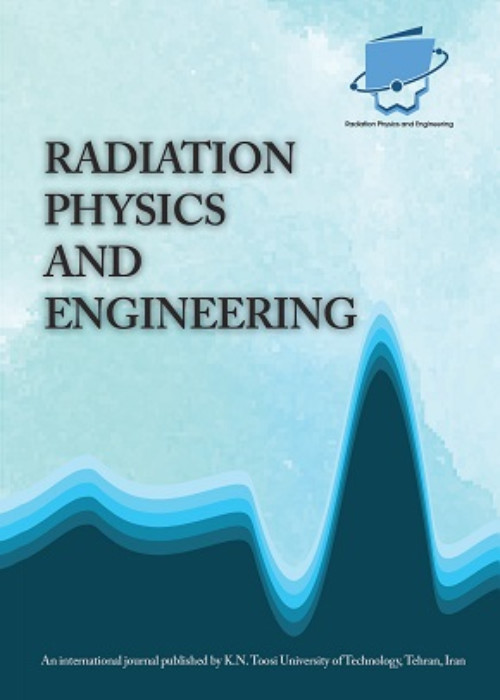فهرست مطالب

Radiation Physics and Engineering
Volume:5 Issue: 1, Winter 2024
- تاریخ انتشار: 1402/10/11
- تعداد عناوین: 8
-
-
Pages 1-9In many human diseases and health cases, therapy of blood transfusion becomes necessary. In spite of the necessity, there are some risks associated with blood used in blood transfusion process. The TA-GVHD (transfusion-associated graft-versus-host-disease) is a problem when a blood transfusion occurs. The blood irradiation with gamma rays in blood bags can eliminate this risk. It should be mentioned that Co-60 sources are widely used for such blood irradiators. The present work investigates Co-60 production yield inside the external irradiation boxes of Tehran Research Reactor (TRR) using MCNPX code. 10-rod and 4-rod Co-59 assemblies were modeled at different external irradiation boxes to investigate their negative reactivity impact on TRR core as well Co-60 buildup rate during 3 years operation of the nuclear core at 4 MW power. The obtained results from MCNPX code showed a 4-rod assembly in linear form could obtain the highest specific activity (Ci.g-1) inside the external irradiation box faced to the core center. The computational results showed about 8 kCi of Co-60 is produced at the optimized irradiation position after 3 years TRR operation at 4 MW power.Keywords: Gamma blood irradiator, Co-60 production yield, TRR, MCNPX code
-
Pages 11-19Using the experimental data in nuclear computing to verify the calculation methods and tools based on numerical and statistical methods has many benefits such as illustrating the quality, ensuring the capabilities, and computer codes validating. Simulation by computer tools is also applicable in the safety analysis of research reactors. In this research, the computer tool (MCNPX 2.7.0: 2011) was verified against the experimental data of neutron flux and spectrum on the sample position of the Tehran Research Reactor (TRR) neutron imaging system by the neutron activation method. To determine the benchmark specifications, the simulation of the system was done at the first step by considering a well-defined facility geometric, material specification and reactor core configuration, fuel elements, and radiation facility (beam tubes and collimator, reactor core, and neutron imaging components). Then the flux and neutron spectrum at the sample position were calculated. In the second step, a set of In (bare and covered by cd) and Au foils and a set of Au, Ni, Ti, and Zr, were placed and exposed almost in front of the reactor E beam tube. The neutron energy spectrum was unfolded by calculating the saturation activity of each foil by SAND-II code, and the neutron flux was calculated. A comparison of the results obtained in two steps shows a relatively good and acceptable agreement (Max. 30% deviation) between the flux and the shape of the flux profile obtained from calculations and experimental data.Keywords: Benchmarking, MCNPX, neutron flux, spectrum, neutron imaging, Tehran Research Reactor
-
Pages 21-39Nowadays, a very particular type of nuclear reactors has become fascinating not only for most nuclear communities but also for the prominent energy suppliers to fix the global warming effects worldwide. They are Small Modular Reactors called SMRs. Usually, SMRs can are classified according to the seven different categories. They include PWRs (especially iPWRs), BWRs, PHWRs, GCR, LMFBR, MSR, and MMRs. Although many different plans have been proposed worldwide, only a few well-established or successive developing action plans are among many innovative conceptual designs. This paper briefly presents a comparison study reviewing the last advances and challenges. The proposed roadmap is strongly correlated and depends on the technology readiness and documentation, technology availability, safety and reliability, design, and construction feasibility for different countries. A new graded approach Phenomenological Identification Ranking Table (PIRT) has been developed and proposed to choose the most profitable and compatible action plan dependent on the situation. Finally, the best feasible designs are compared and proposed against the lack of First-of-A-Kind (FOAK). Furthermore, different options are proposed for different priorities and preferences based on the available nuclear infrastructures. Studies are very profitable to save money and time and develop a strategic action plan for newcomers and developing countries. On the other hand, some exceptional designs have extraordinary advantages for industrial countries and even more for the future of nuclear energy worldwide. Therefore, the proposed roadmap covers short-term, mid-term, and long-term strategies for developing countries and newcomers in the nuclear reactor industry.Keywords: SMR, iPWR, BWR, GCR, LMFR, MSR, MMR
-
Pages 41-47Nuclear-pumped lasers (NPL) are lasers that excite the active laser environment caused by nuclear reaction. Such lasers need ionizing radiation shielding for mixed neutron and gamma fields. In this work, a shielding system for NPL was designed which using 10B(n,α)7Li. In this simulation, we have used MCNPX 2.6.0 Monte Carlo code and the thermal neutron flux as 1×1016 n.cm-2.s-1 for excitation reaction. Such a large neutron flux can be obtained from a reactor source or a heavy ion accelerator. For this work, 10B fuel is covered on the surface of a rectangular cube aluminum shell by using the Monte Carlo method. In the design of the shielding, combinations with different materials have been used with various arrangements in three layers. According to the simulation, the arrangement of Fe2-B-BPE-Pb is a suitable protection compound for such lasers.Keywords: Nuclear-pumped lasers, gamma-neutron shielding, Monte Carlo Method, neutron flux
-
Pages 49-55Today, with the development of nuclear technology and radiation therapy equipment, radiation protection is important. This study aimed to design heavy concrete with high compressive strength and effective protection against neutron and gamma rays. In this study, 11 types of concrete with different mixing designs including 88 samples were made. In these samples, iron ore aggregates galena, limonite, hematite, polypropylene fibers, nanoparticles, micro-particles of silicon, and B4C powder have been used. Concrete quality coefficient, compressive strength, gamma, and neutron attenuation coefficients were measured for all samples. Also, the neutron attenuation coefficient for all samples was calculated using the Monte Carlo simulation (MCNPX) code and compared with the experimental values. The density, neutron attenuation coefficient, and compressive strength of concrete samples varied from 2.37 to 3.17 g.cm-3, from 0.0162 to 0.0306 cm2.g-1, and from 48.0 to 81.3 MPa respectively. The linear gamma attenuation coefficient and gamma-ray tenth value layer (TVL) were obtained from 0.148 to 0.398 cm-1 and 15.74 to 5.85 cm respectively. These results showed that the highest neutron and gamma attenuation coefficients were obtained for concrete containing 70% galena iron ore and 20% boron carbide and the highest compressive strength belonged to sample G15 containing 15% galena iron ore and 1.8% boron carbide. G70 was the best concrete regarding the quality factor, defined as the product of multiplying the compressive strength and linear attenuation coefficients of neutron and gamma.Keywords: Heavy concrete, B4C, Galena, Limonite, Hematite aggregates, Gamma, neutron shielding
-
Pages 57-61
Fricke gel dosimeters obtained by modifications on standard Fricke dosimeter presents some advantages like easy preparation, tissue equivalence, good reproducibility and dose mapping. In this work, dose response characteristics of Gelatin Fricke gel dosimeters was investigated and compared with Fricke agarose gel dosimeters in terms of sesitivity. After prepration of three different formulation of Gelatin Fricke gel dosimeters and gamma irradiation of the samples, a spectrophotometer was applied to measure the optical absorbance of the samples. Results indicate a linear dose range response of 10 to 30 Gy, as well as increased gelatin concentrations cause the sensitivity of the dosimeter to detereorate with a 80% reduction of dose response for a change in gelatin concentration from 3 to 8 weight percent. Obtained coefficient variation verifies the good repeatability of the gel response. The gel dosimeter has no dose rate dependence. Comparison of the most sensitive Gelatin Fricke gel sample with the prepared Fricke agarose gel samples confirm that Fricke agarose dosimeter is more sensitive than Gelatin Fricke gel dosimeter.
Keywords: Fricke gel dosimeters, Gelatin, Agarose, Response curve -
Pages 63-74In this research, the governing dynamic equations of the Bushehr NPP core are studied and modeled using Matlab (Simulink) software. The point kinetic equation with the temperature feedbacks and the fuel-coolant energy balance equations in the time domain were used for this purpose. The model is validated against the rod drop accident data available in BNPP-1 FSAR, and they agreed. Then, this time-domain model is used to find the maximum movement speed of the control rods. For this goal, linear and non-linear rod movement equations have been modeled. In this regard, the maximum withdrawal speed of the working bank (H10) with a worth of 1.1 dollars has been investigated. Using the linear CR model, a speed limit of 9 cm.s-1 has been obtained to prevent the initiation of a reactor trip. The maximum speed using the non-linear model of the CR was found out to be dependent on its initial position. Thus, in three positions of the H10 bank: 100%, 80%, and 50% of the length inside the reactor, the maximum withdrawal speed values were valuated 11.5, 7.7, and 4.4 cm.s-1 respectively. According to the results, among the reactor parameters including power, period, and fuel temperature, which are monitored by the reactor protection system to initiate the reactor trip, the reactor power is the limiting factor for specifying the maximum withdrawal speed. This study is performed using time domain analysis, and the obtained results are consistent with the results reported in the previous research using Laplace transform approach.Keywords: Reactor Dynamic Model, Bushehr NPP, Maximum speed of control rod, Simulink Modelling, Time domain analysis
-
Pages 75-80Gamma radiation indicators are appropriate tools for monitoring visually whether or not the irradiation process has been carried out properly. Among chemical radiation indicators available worldwide, a few are suitable for monitoring low dose ranges (especially for blood irradiation, below 50 Gy). Addressing this scope, PVA-Fricke gel was proposed in this work. Irradiation of the prepared PVA-Fricke gel samples was performed by Co-60 gamma cell unit up to a dose of 80 Gy. Color change of the samples was observed from orange to purple proportional to increasing absorbed dose. Prepared samples were divided into three groups, kept at different environmental conditions, to investigate stability of the gel against temperature and light. Results revealed that the irradiated samples kept at dark and refrigerator were stable for seven days. Optical absorbance measurement of the samples also estimated pre- and post-irradiation color stability. The gel can be easily used to identify processed and unprocessed products in blood irradiation. Although the gel is designed to be a qualitative indicator, it is also a good quantitative dosimeter for gamma rays.Keywords: Chemical radiation indicators, Fricke solution, PVA gelling agent, Optical absorbance, Gamma exposure, Blood irradiation


